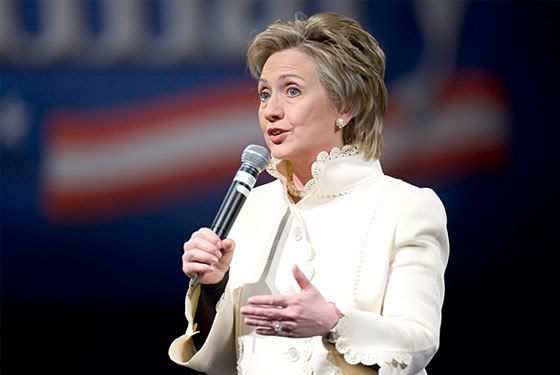
"Hillary has a bold and comprehensive plan to address America's energy and environmental challenges that will establish a green, efficient economy and create as many as five million new jobs." A bold and firm stance for the ever so popular Hillary Clinton for the 2008 presidential election. Just how does she propose to accomplish all this and how is she suading those who vote to support her argument? At first glance many people do not read into what is said in the article and how she goes about it. This article on New Energy and New Jobs uses certain rhetorical stategies including the appeals of logos and pathos to support her thesis and stance on the issues of energy and new jobs by the dilivery and arranement of the material.
The first words written here are here thesis, "Hillary has a bold and comprehensive plan to address America's energy and environmental challenges that will establish a green, efficient economy and create as many as five million new jobs." It is a very strong thesis, boldly stated and clearly defined. She wants to create new and more evironmentally friendly energy and new jobs, a proper and fitting description of her stance on the issue. She plans to implement these effects by reducing greenhouse gas emissions by eighty percent by 2050 and by cutting foreign oil imports to a third of what it is now by 2030. It is an effective scare tactic, "Hillary's plan will reduce America's reliance on foreign oil and address the looming climate crisis." This appeals to logos because a voter has been address about this crisis and therefore logically they will want to take action and in this case the answer is by voting Hillary into office. However, before one decides to vote for Hillary, one must know the steps she wishes to take to acheive this goal.
The process Hillary has devised to correct our energy and climate process is illustrated and classified in the fourth and fifth paragraph of the article. For example "Hillary would transform our economy from carbon-based to clean and energy efficient, jumpstarting research and development through a $50 billion Strategic Energy Fund and doubling investment in basic energy research." People are able to see how this fits into a larger scheme when she goes on to say "She would also spur the green building industry by funding the retrofitting and modernization of 20 million low-income homes," an appeal to pathos for those lucky 20 million low-income home owners for a home makeover would improve the quality of life of those lucky many. So far her argument is a strong one and very firm relying on evidence and kairos, adressing the present concerns of out time like those of global warming, the use of energy, and the stability of our economy. In the sixth paragraph her rhetorical approach changes drastically.
"To take the steps necessary to transition to a clean and renewable energy future, Hillary will urge all of the nation's stakeholders to contribute to the effort." Wow, that is a bold and drastic leap in order to get the whole nation from homeowner to business involved across the nation. Just how does she plan on doing this? "Automakers will be asked to make more efficient vehicles; oil and energy companies to invest in cleaner, renewable technologies; utilities to ramp up use of renewables and modernize the grid; coal companies to implement clean coal technology . . ." Note in both of these quotes the use of verbs. She uses "urge" and "ask" both of which may not produce any effect. For all we know stakeholders and large companies may say no. However, the way the material is delivered and aranged puts emphasis on the action by setting up a series without repeating the verb. This creates a logos appeal called post hoc fallacy. When reading the material we overlook the verb and take the actions as concrete, like they will happen, when actually none of them may happen. Therefore the cause and the effect can esilly confused or misinterpreted leading to a hasty generalization of the effect.
The first words written here are here thesis, "Hillary has a bold and comprehensive plan to address America's energy and environmental challenges that will establish a green, efficient economy and create as many as five million new jobs." It is a very strong thesis, boldly stated and clearly defined. She wants to create new and more evironmentally friendly energy and new jobs, a proper and fitting description of her stance on the issue. She plans to implement these effects by reducing greenhouse gas emissions by eighty percent by 2050 and by cutting foreign oil imports to a third of what it is now by 2030. It is an effective scare tactic, "Hillary's plan will reduce America's reliance on foreign oil and address the looming climate crisis." This appeals to logos because a voter has been address about this crisis and therefore logically they will want to take action and in this case the answer is by voting Hillary into office. However, before one decides to vote for Hillary, one must know the steps she wishes to take to acheive this goal.
The process Hillary has devised to correct our energy and climate process is illustrated and classified in the fourth and fifth paragraph of the article. For example "Hillary would transform our economy from carbon-based to clean and energy efficient, jumpstarting research and development through a $50 billion Strategic Energy Fund and doubling investment in basic energy research." People are able to see how this fits into a larger scheme when she goes on to say "She would also spur the green building industry by funding the retrofitting and modernization of 20 million low-income homes," an appeal to pathos for those lucky 20 million low-income home owners for a home makeover would improve the quality of life of those lucky many. So far her argument is a strong one and very firm relying on evidence and kairos, adressing the present concerns of out time like those of global warming, the use of energy, and the stability of our economy. In the sixth paragraph her rhetorical approach changes drastically.
"To take the steps necessary to transition to a clean and renewable energy future, Hillary will urge all of the nation's stakeholders to contribute to the effort." Wow, that is a bold and drastic leap in order to get the whole nation from homeowner to business involved across the nation. Just how does she plan on doing this? "Automakers will be asked to make more efficient vehicles; oil and energy companies to invest in cleaner, renewable technologies; utilities to ramp up use of renewables and modernize the grid; coal companies to implement clean coal technology . . ." Note in both of these quotes the use of verbs. She uses "urge" and "ask" both of which may not produce any effect. For all we know stakeholders and large companies may say no. However, the way the material is delivered and aranged puts emphasis on the action by setting up a series without repeating the verb. This creates a logos appeal called post hoc fallacy. When reading the material we overlook the verb and take the actions as concrete, like they will happen, when actually none of them may happen. Therefore the cause and the effect can esilly confused or misinterpreted leading to a hasty generalization of the effect.
To support this hasty generalization the evidence is stacked with examples. "A new cap-and-trade program that auctions 100 percent of permits alongside investments to move us on the path towards energy independence; An aggressive comprehensive energy efficiency agenda to reduce electricity consumption 20 percent from projected levels by 2020 by changing the way utilities do business, catalyzing a green building industry, enacting strict appliance efficiency standards, and phasing out incandescent light bulbs; . . ." The other hasty generalization is that new jobs will be created. It is stated in the thesis of the first sentence but no where is it substatially supported creating the logical fallacy called red herring.
The effect logos and pathos along with all the other rhetorical appeals create a strong argument that seems to be very effective when supporting a thesis in elections such as this. Overall there is yet one more strategy this article uses, the advertisers stance. It is a strategy that will effectively bring in voters for Hillary Clinton by avoiding the ethos of the candidate and the quality of the text. It is like buying a product oblivious to the character of the product; that is exactly what this article wants-to win votes by ignoring certain details and appealing to what seems important to the reader!
